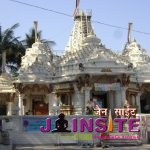Shri Parshwanath Bhagwan
Address
Moodabidri,District : Dakshina Kannada 574227, Karnataka
LocationMoodabidri (also called Mudabidri), an ancient center of Jain learning, is a small town about 37 km northeast of Mangalore, in Karnataka. It is situated at a beautiful spot in the midst of hills. Moodabidri was a center of Jain religion, culture, art and architecture during 14th – 16th centuries. It is famous as the “Jaina Kashi” of the South. It is sanctified by the stay of great saints and poets. Jains from all parts of India come here to worship in the famous 18 Jaina basadis that are dedicated to the memory of the Tirthankaras. Jaina Basadis Moodabidri center of Jain religionMoodabidri witnessed an unprecedented growth as a center of Jain religion, culture, art and architecture during 14th to 16th centuries and more than 18 Jain temples, known as Basadis, were constructed during this period. The most famous among them are Guru basadi, Tribhuvana Tilaka Chudamani Basadi and Ammanavara Basadi. The Guru basadi is believed to be the earliest of the Jain monuments of this place (714 AD). It is also called the Siddhantha Basadi and Hale (Old) Basadi. Lord Parshwanatha the 23rd Thirthankar of Jainism is the presiding deity of this temple. A beautiful stone idol of Parshwanatha, about 3.5 metres tall, is installed in the sanctum of this basadi.It is in this basadi that the rare Jain palm leaf manuscripts of 12th century A.D. known as ‘Dhavala texts’ were discovered. The Tribhuvana Tilaka Chudamani basadi is the largest of its kind in coastal Karnataka and is considered to be the most ornate of the Jain temples of this region. Due to the large number and variety of pillars in this basadi it is known as Thousand pillared temple (Savira Kambada Basadi). The Jain tombs and Nyaya basadi at Kodangallu, in the outskirts of Moodabidri are movements of great historical interest. The Jain tombs and Nyaya basadi at Kodangallu, in the outskirts of Moodabidri |
|
This is a huge granite construction originally built in 1430 A.D and was completed in three stages. The 2.5 metres tall bronze image of Lord Chandranatha Swami housed in the sanctum of this basadi is considered to be an image of utmost importance in Jainism. This huge, three storied movement was constructed by the collective effects of the rulers, the Jain Swamiji, merchants and also the common people by this ancient city. The most beautiful part of this temple is the open pillared hall in front, consisting by a rich variety of ornate pillars. The pillars and the roof this open hall are decorated with beautiful and minute carvings typical of Vijayanagara style. The 15-meter tall freestanding single stone pillar called manasthambha in front of the basadi, is indeed a beautiful art. There are beautiful images of Jain Trirthankar, Yakshas and Yakshis in every Jain basadi of Moodabidri. The stucco images in the Leppada basadi and Ammanavara Basadi are magnificent. The other basadis at Moodabidri are the following : (1) Badaga basadi (2) Shettara basadi (3) Hire basadi Nagagala Devi, the queen of Bhairava Raja, erected the Manastambha, a huge monolith of a height of 50 feet, in front of the basadi. The Manastambha Centre of Jain literatureMoodabidri was a centre of Jain literature too. Ratnakara Varni, the doyen of medieval Kannada literature and the author of Bharatesha Vaibhava belonged to this place. The famous Jain canonical texts known as Dhavala texts and also a number of palm leaf manuscripts of immense literacy value are in the possession of the Jain monastery here. During Mughal assaults, the old Jain texts were shifted from Shravanabelagola to the safer Moodbidri. Rediscovered in the 1800s, these Moodbidri Manuscripts — Prakrit texts copied in old Hale-kannada script, with pinpricks on palm leaves — are revered as the oldest (scribed circa 1,060 A.D.) written materials of the tradition going back to Arihant. The collection of 3 ancient manuscripts: Dhavala, Jayadhavala and Mahadhavala, collectively called the “Siddhanta” in Digambara tradition. For many centuries, the only copy of the Siddhanta was this collection. |
HistoryMoodabidri was also the seat of the Chowta’s, a local Jain ruling family, who were originally ruling from Puthige, a village about 5 km from here. This area was ruled by the Jain Chautar dynasty for about 700 years. Their descendants still live in an old palace. They shifted their capital to Moodabidri in the 17th century, where they constructed a palace, the remains of which can still be seen. Moodabidri still maintains its old charm as an important Jain centre coastal Karnataka. The city has a large population of Jains who keep the spirit of Jainism still alive. Many Jain festivals are also being celebrated here throughout the year. Moodabidri continues to the most sought after pilgrimage centre of the Jains from all over country. Moodbidri Digambar Jain Basadi now in a shamblesMoodbidri which is one of the largest Jain pilgrimage centres in the world is now in a shambles. The city’s culture -rich temple, the Tribhuvana Tilaka Chudamani, popularly known as the 1000-pillar Basadi, is gradually beginning to lose its charm. The temple, built in 1430, is now a sorry sight, with its crumbling walls and damaged roofs. This is due to the highway traffic and mining in the vicinity. In fact a part of the temple complex also fell off recently. The three-storey temple complex is managed by a private trust called Dhavala Thraya Trust under the Jain Mutt of Moodbidri. The trust is facing financial difficulties and unable to maintain the temple. Swamiji of Jain Mutt Bhattaraka Charukirti Panditacharyavarya is observing the damage but for the shortage of funds unable to carryout the necessary maintenance. He says that appeal to the government regarding mining and traffic problems is not responded. In spite of the fact that local MLA is a Jain community member nothing is happening. |










